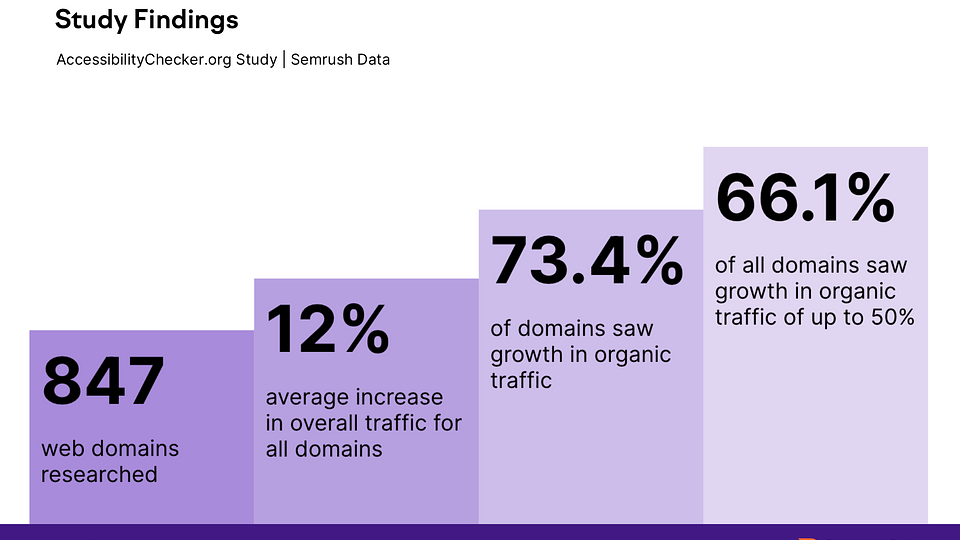
Marketing Solutions

Benefits Going with Being Complient!
- Helps With Your SEO
- Help Build Your Rank
- Speeds Up Your Website
- Possible Tax Credit
- Helping make a better experience for those with Disabilities!
- More Client/Customers/Patiences = More Income
Ready To Come on board?
What is Web Accessibility?
How can website owners, developers, and brands ensure that their online content is navigable for all users? And what are the implications of making the move toward inclusivity?
Web accessibility refers to the ease with which differently able users can understand web pages. The concept also extends to internet users in certain situations, such as those using mobile devices or experiencing low internet bandwidth, to increase the likelihood of a positive experience with your site across various user conditions.
From alt text that describes photos for users with visual impairments to intuitively organized written content so users can efficiently navigate through your site and find the information they need, the concept comes down to web page usability for all people.
Websites can increase accessibility through a variety of plug-in technologies and remediation solutions that work to ensure content is decipherable to as many people in as many situations as possible. It’s a pressing issue, particularly given the estimate that 90% of websites are inaccessible to users who utilize interpretive technologies.
So are you all in? Are you going to make
America a better place
for those less future then you! Let's make it easier for people to spend money with you and why helping them navigate your website.
America a better place
for those less future then you! Let's make it easier for people to spend money with you and why helping them navigate your website.

Why Does Web Accessibility Matter?
Web accessibility is an important moral goal, as the internet shouldn’t leave anyone left out of its rich resources. In addition to ethical motivations, sites also work toward accessibility to comply with legal requirements, particularly as outlined by the Americans with Disabilities Act (ADA). Web accessibility is also vital for business. Every organization can benefit from making itself accessible to a wider group of visitors.
Enacted in 1990, the ADA originally spoke primarily to the need for accommodations in physical spaces while explicitly outlawing discrimination based on disability. It also includes requirements for the equitable use of public resources, stating, “No qualified individual with a disability shall, by reason of such disability, be excluded from participation in or be denied the benefits of services, programs, or activities of a public entity.”
So, when did the law extend to websites as public entities? Since the early 2000s, the Justice Department has maintained that ADA compliance includes access to websites, and a 2008 amendment to the ADA codified this expansion of the legislation.
Enacted in 1990, the ADA originally spoke primarily to the need for accommodations in physical spaces while explicitly outlawing discrimination based on disability. It also includes requirements for the equitable use of public resources, stating, “No qualified individual with a disability shall, by reason of such disability, be excluded from participation in or be denied the benefits of services, programs, or activities of a public entity.”
So, when did the law extend to websites as public entities? Since the early 2000s, the Justice Department has maintained that ADA compliance includes access to websites, and a 2008 amendment to the ADA codified this expansion of the legislation.
It seems intuitive that increasing the populations who can access your website could lead to growth in organic traffic. For instance, it’s estimated that more than 1 million U.S. adults over the age of 40 are blind. Could you unlock their business and brand loyalty with web accessibility?
Plus, with Google constantly calculating search engine result page (SERP) rankings by evaluating sites based in part on web page usability and user experience, it logically follows that websites with more accessibility features would be prioritized over sites without those accommodations. So, marketers have long assumed that accessibility features drive online visibility and enhance SEO. Web developers work with this assumption every day.
But until now, the accessibility hypothesis had never been proven.
Plus, with Google constantly calculating search engine result page (SERP) rankings by evaluating sites based in part on web page usability and user experience, it logically follows that websites with more accessibility features would be prioritized over sites without those accommodations. So, marketers have long assumed that accessibility features drive online visibility and enhance SEO. Web developers work with this assumption every day.
But until now, the accessibility hypothesis had never been proven.
Introducing the first concrete study on accessibility and discoverability
Introducing the first concrete study on accessibility and discoverability
AccessibilityChecker.org set out to find conclusive evidence around the claim that website accessibility enhances SEO.
BuiltWith, a tool that determines which technologies are being used to run specific websites, was able to identify 847 websites that use accessibility remediation solutions, as well as when they installed those services. By working with these sites and considering the exact date when they enhanced their accessibility measures, Semrush leveraged its own API developer hub to deduce each site’s traffic at two critical times: three months before the accessibility solution was integrated and three months after.
AccessibilityChecker.org set out to find conclusive evidence around the claim that website accessibility enhances SEO.
BuiltWith, a tool that determines which technologies are being used to run specific websites, was able to identify 847 websites that use accessibility remediation solutions, as well as when they installed those services. By working with these sites and considering the exact date when they enhanced their accessibility measures, Semrush leveraged its own API developer hub to deduce each site’s traffic at two critical times: three months before the accessibility solution was integrated and three months after.
Want to know more? See my video!
Ready To Come on board?
Need more reason to join the elite few that are
making this a better experience when doing business!
making this a better experience when doing business!
Is Web Accessibility Key to
Driving Organic Traffic?
Driving Organic Traffic?
Many marketers operate on the assumption that web accessibility increases SEO. In collaboration with AccessibilityChecker.org and Built With, we set out to prove the claim by analyzing over 800 websites. The study suggests that digital accessibility is paramount for online discover ability. Here are our findings at a glance:

Read about law suite
Even though it would be unfair to describe most ADA lawsuits this way, some experts call it the wave of ‘corporate extortion’New Window . Businesses are being urged to take a serious look at their websites and ensure that their digital presence is accessible to all users. Against these kinds of lawsuits, businesses face financial penalties of not being compliant.
In cases where both parties agree to settle, currently, the average is set at a minimum of $20,000. If the company loses the case in court, the fine can be up to $55,000. This excludes the cost of attorney fees, paying the plaintiff a huge compensation for damages and redesigning the websites to become compliant within a matter of days. Given these numbersNew Window , it is clear that the cost of not being compliant can be crushing, even for a medium business with a sizable budget.
Of course, there is no reason to assume this trend will be limited to the U.S. Many other governments around the world have also incorporated web accessibility requirements such as the E.U.,New Window AustraliaNew Window , and the United Kingdom.New Window Many of these laws will demand the same—if not more stringent—levels of compliance, as they, like their American counterpart, are almost all based on the internationally recognized WCAG guidelines.

The A D A Tax Credit?
1. What is the A D A Tax Credit?
The A D A Tax Credit was created to incentivize and support businesses to invest in accessibility - online and offline. Qualifying businesses that design and maintain accessible websites, and are compliant with the Americans with Disabilities Act (A D A), could earn back 50% of the cost they invested in their accessibility efforts after a $250 minimum fee is subtracted.
2. Who is eligible for the A D A Tax Credit?
It’s available to businesses that generated $1M or less last year, or to businesses with 30 or fewer full-time employees.
3. How much can I expect back from my tax credit, and how does it work?
The maximum credit you’re allowed to receive is $5,000. For example, let’s say a business’ annual accessibility fee is $490. The first $250 is subtracted from that. That leaves $240. Then, you’re getting 50% of what’s left, which is $120.
4. Is this an annual credit or a one-time saving?
The tax credit can be received on an annual basis if you employ 30 or fewer full-time employees or generate $1M or less each year.
5. How does the A D A cover websites if it was written to apply to physical spaces?
The original A D A was drawn up and enacted in the 90s, with the intention of applying its rules and regulations to the evolving digital landscape. The Department of Justice has reinforced this intention with public updates in 2018 and 2022, stating that websites are places of public accommodations and must be accessible to comply with A D A requirements.
6. What was the estimated number of demand letters in 2021?
While demand letters have grown during 2022, 2021 recorded around 300,00 demand letters delivered. In 2020 we saw 265,000 demand letters given. Demand letters that evolve into lawsuits typically settle in the range of $20,000 - $100,000. Certain states like California and New York have come down a lot harder on small businesses, so business owners in those states should be even more aware of the likelihood of receiving a demand letter.
7. Do not-for-profit organizations qualify for the A D A Tax Credit?
Not-for-profit organizations need to consult with a CPA or tax professional to confirm whether they are eligible for the tax credit. Social enterprises or organizations may be eligible, pending the IRS qualifications that must be met in accordance. Often, we’ve seen that CPA firms do not know this credit exists, so make sure to tell your CPA the form number (8826).
8. How else can I maximize my efforts to get the entire $5,000 tax credit?
Accessibility is not just access Widget and we have a full range of services that are sometimes required for A D A compliance. At times, our clients need user testing or perhaps they need PDF remediation, and that could all fall under the tax credit, as well. You also want to have your website team or agency consider things like font size, button placement, and more in their website design choices. Listing these implemented and paid-for accessibility services could help you get the full amount back.
9. Is there an audit trail and do I need to provide one for my tax form?
Yes, audit trails exist, and you can provide one on Form 8826 if you or your tax professional thinks it’s necessary; an audit trail shows accessibility efforts that are being made consistently.
10. What are some good resources for understanding the A D A
Tax Credit?
You’re able to find Form 8826 on the IRS government website, where you can also research the rules and stipulations regarding the tax credit itself. Head over to “Forms & Instructions” at the top of the page, and you can research any information regarding accessibility documents.
11. Is there any additional information that you need to provide about access Widget or any other accessibility services on the tax credit form?
No. The form is super simple and is built into your yearly tax return. Your tax professional can easily fill it out and state the amount that was spent on accessibility efforts.
For more information regarding The Disabled Access Tax Credit and an additional tax deduction, you can also visit the IRS Tax Credits and Deductions page on the Americans with Disabilities
